
Which banana plant to grow depending on your region?
Browse our selection to find the banana plant suitable for your garden.
Contents
In order to choose which banana plant can thrive in your garden, it’s worth noting that there are dozens of varieties of banana plants. Although they may have different climate needs, banana plants generally have similar growing requirements.
Remember that some species and varieties are purely greenhouse plants, with sizes not exceeding 2 m when grown in pots. Other varieties can live outdoors in summer and then be moved to a greenhouse throughout winter.
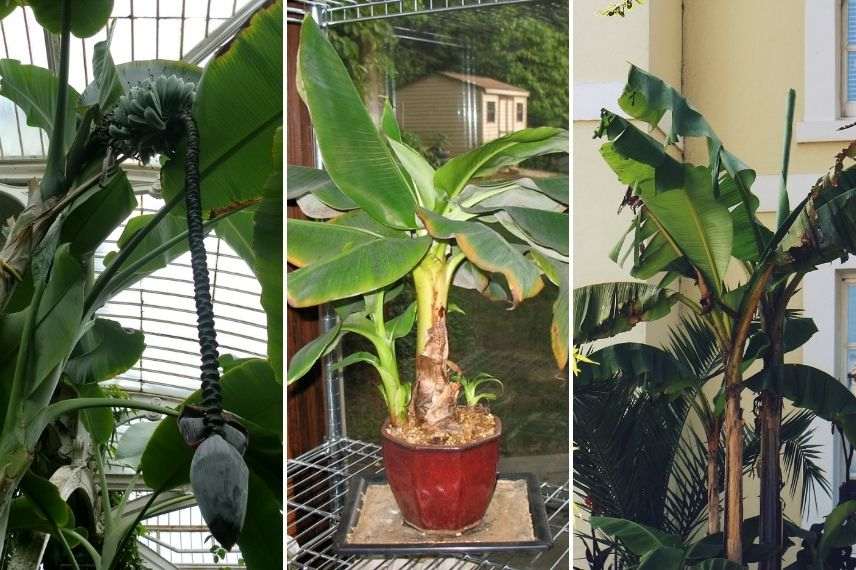 Potted banana plants will need to be stored during winter
Potted banana plants will need to be stored during winter
Discover our tips for successfully growing a banana plant based on the region where you live.
→ Learn more in our advice sheet: Growing a banana plant in open ground
You live in the Mediterranean region.
If frost is non-existent or very infrequent near the Mediterranean, the available selection of outdoor banana plants is significant. The following species will be described in the chapters concerning regions with more limited choices.
- Musa basjoo and its various varieties. Ideally, it requires sun or partial shade (not full sun), regular watering, even very regular during the development period, and rich, well-amended, well-drained soil;
- Musa sikkimensis with foliage more resistant to wind;
- Musa velutina, smaller (1.50 m) that flowers pink and produces non-edible pink bananas;
- Ensete ventricosum or Abyssinian banana plant that grows quickly and produces enormous leaves;
- Musella lasiocarpa which withstands cold well.
Several of these species produce fruit, but they are inedible and do not reach ripeness, so do not expect bunches of 10 kg!!!
- Musa acuminata ‘Dwarf Cavendish’, also known as the “Dwarf Canary Banana” has beautiful dark green foliage speckled with brown. Quite delicate, but can be grown in the South. Elsewhere, it is better to keep it in a pot to shelter it in a temperate greenhouse or conservatory.
 Flower and foliage of the ‘Dwarf Cavendish’ banana plant to be grown in a conservatory outside the Mediterranean zone
Flower and foliage of the ‘Dwarf Cavendish’ banana plant to be grown in a conservatory outside the Mediterranean zone
Read also
Potted Banana tree: planting and careYou live on the Atlantic fringe.
- Musella lasiocarpa, the dwarf banana, also known as “blue banana” or “yellow-flowered banana,” is a beautiful plant that does not exceed 1.5 m in height. Suitable for cultivation both in the ground and in pots, its leaves are a lovely light green, reaching up to 30 cm in length. Another point in its favour is the production of a large, bright yellow inflorescence that lasts for a very long time, even exceeding seven months. The subsequent fruits are not edible. Native to China and Vietnam. Suitable for any sheltered region, but should be monitored (depending on humidity levels) as it can withstand temperatures as low as -10 to -15 °C. It tolerates wind and sea spray.
- Musa sikkimensis, the Sikkim banana, is a very interesting and recently introduced species, native to the Himalayan region, with leaves that can reach up to 2 m in length and 60 cm in width. They are extremely glossy and a lovely green; the younger leaves have a strong purple underside and sometimes chocolate-coloured stripes that create a very spectacular chromatic effect. The insignificant flowering of this banana occurs in mid-summer and is soon followed by the production of inedible fruits. This is a fairly hardy banana that can reach 4 m in height. It easily withstands temperatures down to -12 °C, but winter protection for the crown is always recommended.
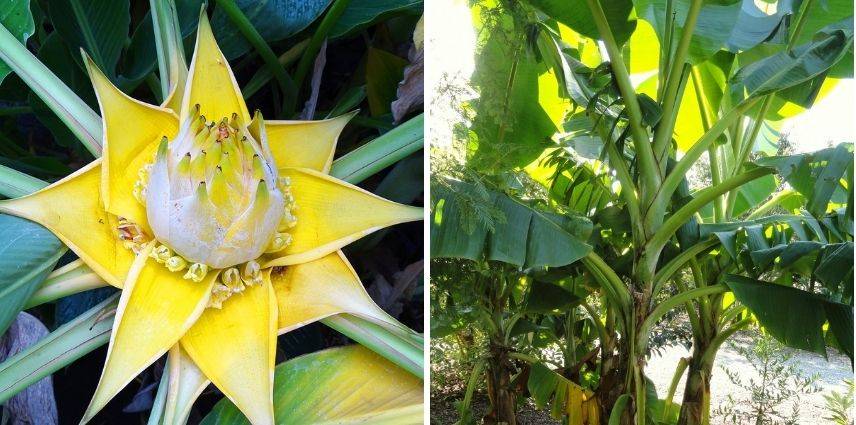 Spectacular flower of the banana Musella lasiocarpa. On the right: Sikkim banana
Spectacular flower of the banana Musella lasiocarpa. On the right: Sikkim banana
Discover other Musa - Banana tree
View all →Available in 3 sizes
Available in 1 sizes
Available in 2 sizes
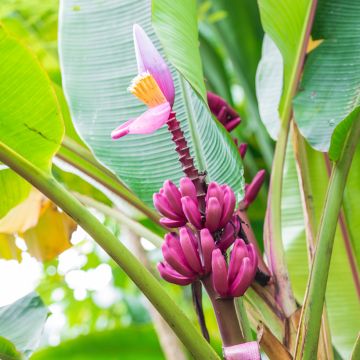
Available in 1 sizes
Available in 1 sizes
Available in 1 sizes
Available in 1 sizes
Available in 1 sizes
Available in 2 sizes
You live in an oceanic region.
- Ensete ventricosum, the red Ethiopian banana, also known as “false banana” or “Ethiopian banana,” is native to East Africa. It can reach up to 4 m with leaves up to 2 m long. They emerge with beautiful red hues that later only remain in the midrib, turning dark green elsewhere. This large banana plant produces stunning spikes of white flowers over 1 m long. It has very vigorous growth.
- The cultivar ‘Maurelii’ is extremely ornamental due to its immense leaves, sometimes red, sometimes ruby, and others almost black, matching its flowering. It is suitable only for the southern coast of the Côte d’Azur and the Atlantic Coast in the ground and in a sheltered position. It can withstand temperatures as low as -10 °C for a short period.
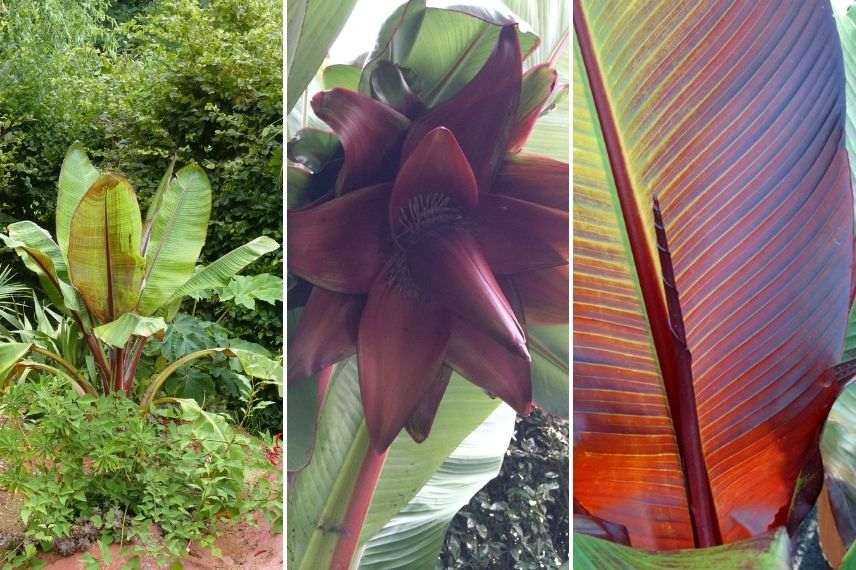
Red Abyssinian banana grown for its rapid growth and the great beauty of the ‘Maurelii’ variety
Read also
Banana plant: how to overwinter it?You live in a semi-continental climate region.
- Musa itinerans, the traveller’s banana is a tall, rhizomatous plant with beautiful blue-green leaves up to 3 m long, often with a red underside. The plant can grow up to 7 m. Hardy, it withstands temperatures down to -12 °C. Its stem regrows from the stump, which can be planted in the ground in all regions with a mild climate. It also tolerates shaded locations.
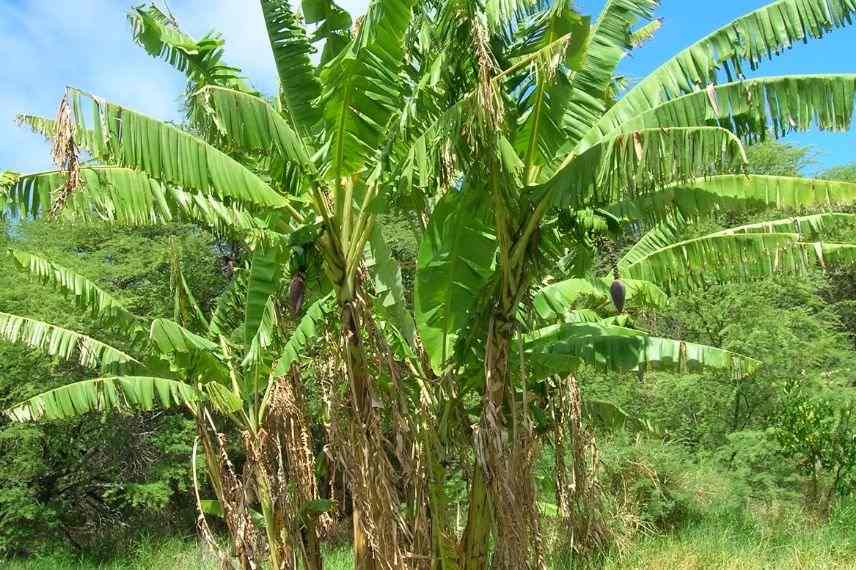 Hardy in mild regions, the traveller’s banana is best suited for large spaces
Hardy in mild regions, the traveller’s banana is best suited for large spaces
- Musa Basjoo, the Japanese banana is the banana plant for all gardeners, even beginners. Its leaves can reach up to 3 m long and about 30 cm wide. It can grow up to 5 m tall in good climatic conditions. At the end of summer, it produces pendulous cream-coloured flowers; then it bears greenish-yellow fruits, rich in very hard black seeds, up to 6 cm long. It is one of the most frost-resistant banana plants. It can be grown almost anywhere, but not in pots, given its size at maturity. To achieve more vigorous growth, it is recommended to protect its stem in winter, pay particular attention to drainage, and position it south-facing so that moisture dries out as early as possible each day.
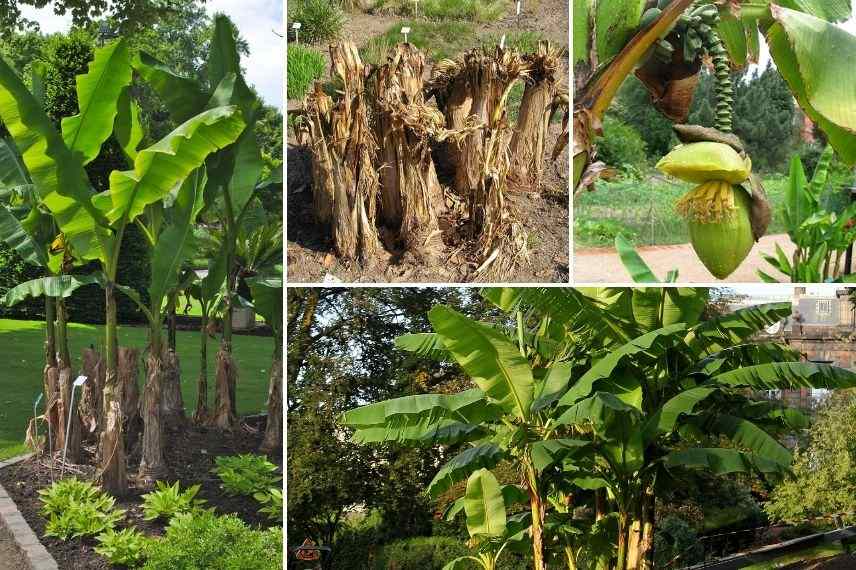 The Japanese banana, the most commonly encountered, is not afraid of frost and regrows from the stump
The Japanese banana, the most commonly encountered, is not afraid of frost and regrows from the stump
- The variety ‘Sakhalin’ of the Japanese banana is even hardier (resistant down to -16 °C) and has thicker, darker leaves that are wind-resistant.
You live in a mountainous region with a continental climate.
Musa velutina, the pink-flowered banana plant is an interesting species for its beautiful bright green foliage and small size (never more than 1.5 m). Its main attraction lies in its pink flowering followed by abundant (inedible) fruits of a striking bright pink with a velvety skin. It can only withstand short frosts (-5 to -8 °C) if well protected. However, it can be grown in a pot and stored in a cold or temperate greenhouse during winter.
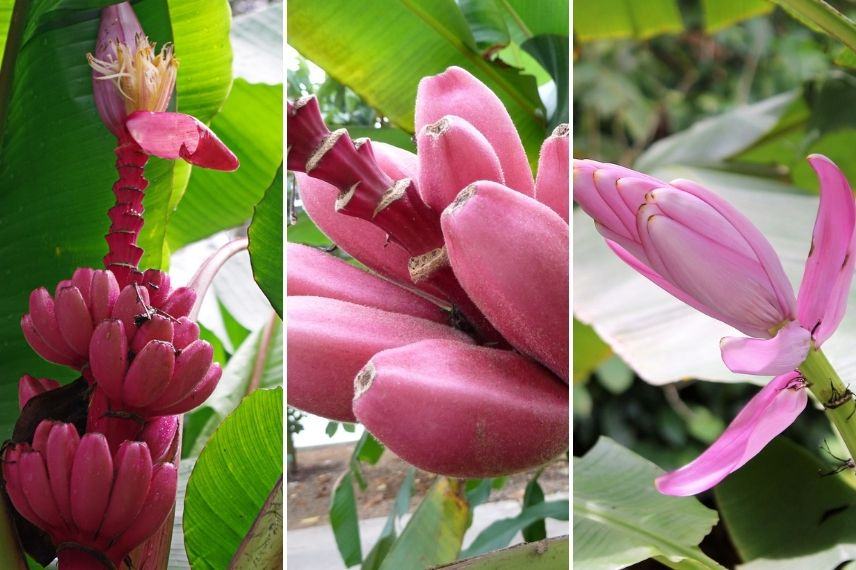
Splendour of the pink-flowered banana plant with porcelain-like appearance
To find out more
Discover all our tips in our comprehensive guide: Banana plant: planting, cultivation and maintenance, in pot or in garden
We have selected 5 cold-resistant banana plants!
- Subscribe!
- Contents
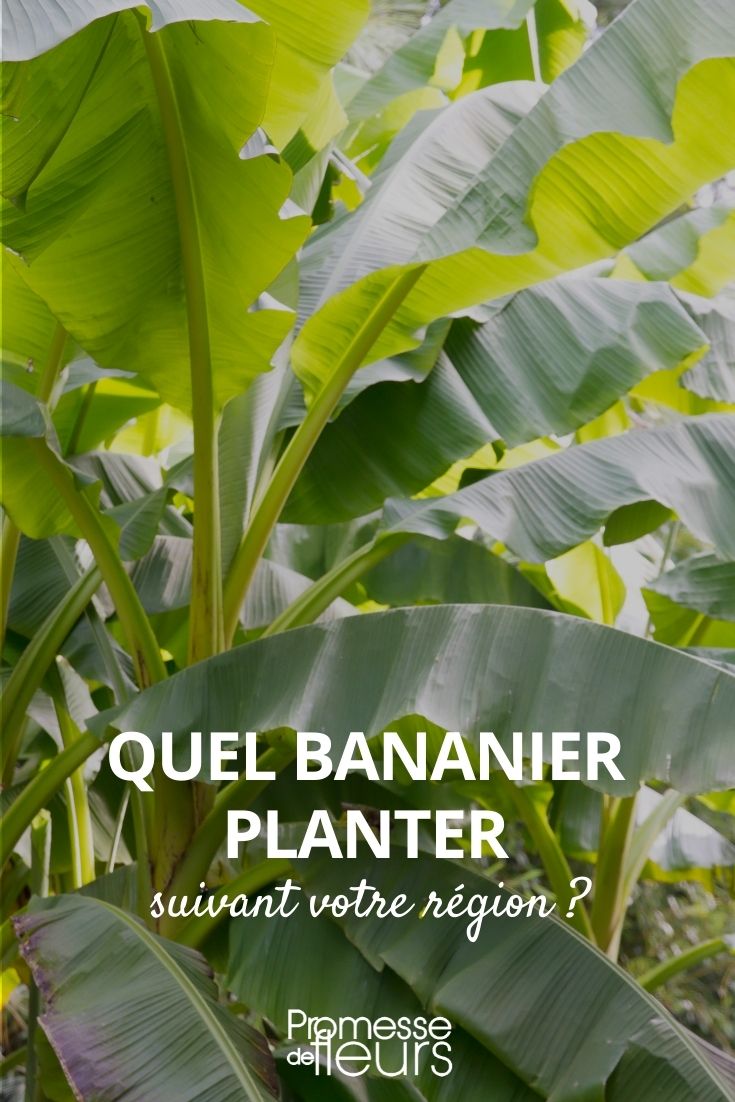































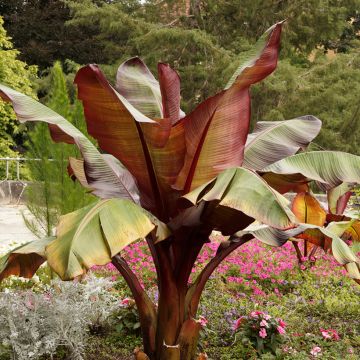
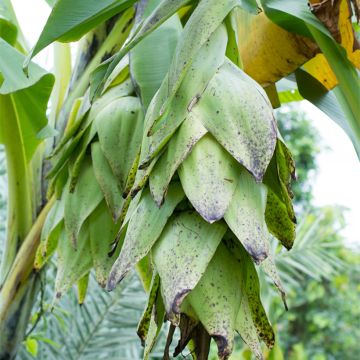
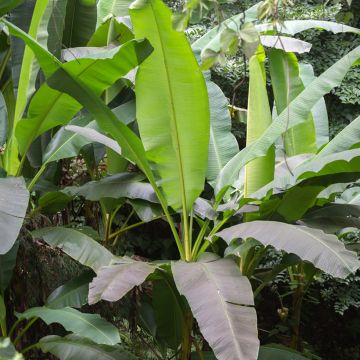
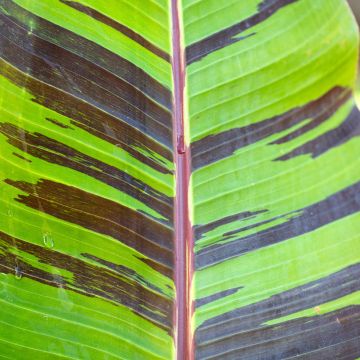
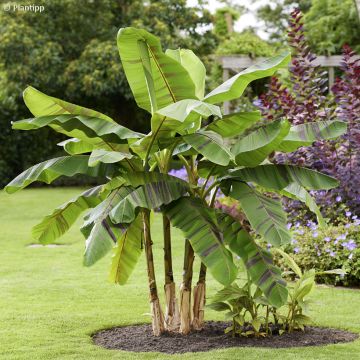


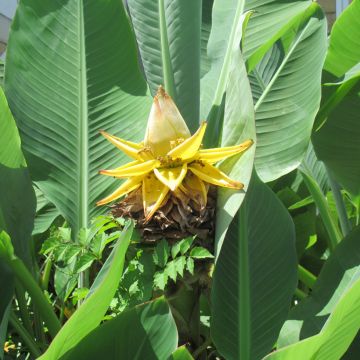
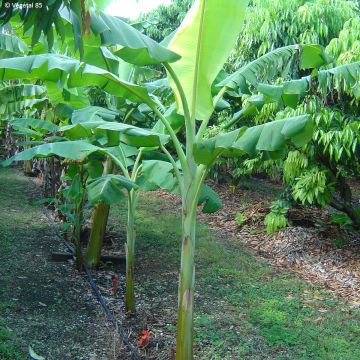
Comments